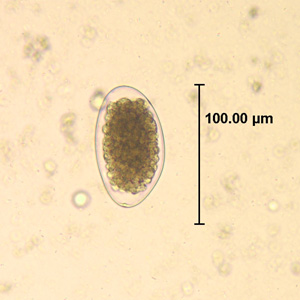Trichostrongylidae
Trichostrongylidae is a family of nematodes (roundworms) that are primarily parasitic in the gastrointestinal tract of vertebrates, particularly ruminants such as cattle, sheep, and goats. These parasites are of significant veterinary importance due to their impact on livestock health and productivity.
Morphology[edit | edit source]
Members of the Trichostrongylidae family are typically small, slender worms. They possess a simple mouth opening without lips and a well-developed buccal capsule. The esophagus is club-shaped, and the males often have a bursa, which is used for attachment during copulation.
Life Cycle[edit | edit source]
The life cycle of Trichostrongylidae involves both free-living and parasitic stages. Eggs are passed in the host's feces and hatch into larvae in the environment. The larvae undergo several molts before becoming infective. The infective larvae are ingested by the host while grazing. Once inside the host, they develop into adult worms in the gastrointestinal tract, where they reproduce and continue the cycle.
Pathogenesis[edit | edit source]
Trichostrongylidae infections can lead to a range of clinical signs in the host, including diarrhea, weight loss, reduced feed efficiency, and in severe cases, death. The severity of the disease depends on the worm burden, the species of Trichostrongylidae involved, and the host's immune status.
Diagnosis[edit | edit source]
Diagnosis of Trichostrongylidae infections is typically achieved through fecal examination to identify eggs. More advanced techniques, such as polymerase chain reaction (PCR) and enzyme-linked immunosorbent assay (ELISA), can be used for species-specific identification and to assess the level of infection.
Control and Treatment[edit | edit source]
Control of Trichostrongylidae infections involves a combination of anthelmintic treatments and management practices to reduce exposure to infective larvae. Rotational grazing, maintaining proper sanitation, and selective breeding for resistant livestock are common strategies. Anthelmintic resistance is a growing concern, necessitating the use of integrated parasite management approaches.
Notable Genera[edit | edit source]
Some notable genera within the Trichostrongylidae family include:
Related Pages[edit | edit source]
Categories[edit | edit source]
Search WikiMD
Ad.Tired of being Overweight? Try W8MD's physician weight loss program.
Semaglutide (Ozempic / Wegovy and Tirzepatide (Mounjaro / Zepbound) available.
Advertise on WikiMD
|
WikiMD's Wellness Encyclopedia |
| Let Food Be Thy Medicine Medicine Thy Food - Hippocrates |
Translate this page: - East Asian
中文,
日本,
한국어,
South Asian
हिन्दी,
தமிழ்,
తెలుగు,
Urdu,
ಕನ್ನಡ,
Southeast Asian
Indonesian,
Vietnamese,
Thai,
မြန်မာဘာသာ,
বাংলা
European
español,
Deutsch,
français,
Greek,
português do Brasil,
polski,
română,
русский,
Nederlands,
norsk,
svenska,
suomi,
Italian
Middle Eastern & African
عربى,
Turkish,
Persian,
Hebrew,
Afrikaans,
isiZulu,
Kiswahili,
Other
Bulgarian,
Hungarian,
Czech,
Swedish,
മലയാളം,
मराठी,
ਪੰਜਾਬੀ,
ગુજરાતી,
Portuguese,
Ukrainian
Medical Disclaimer: WikiMD is not a substitute for professional medical advice. The information on WikiMD is provided as an information resource only, may be incorrect, outdated or misleading, and is not to be used or relied on for any diagnostic or treatment purposes. Please consult your health care provider before making any healthcare decisions or for guidance about a specific medical condition. WikiMD expressly disclaims responsibility, and shall have no liability, for any damages, loss, injury, or liability whatsoever suffered as a result of your reliance on the information contained in this site. By visiting this site you agree to the foregoing terms and conditions, which may from time to time be changed or supplemented by WikiMD. If you do not agree to the foregoing terms and conditions, you should not enter or use this site. See full disclaimer.
Credits:Most images are courtesy of Wikimedia commons, and templates, categories Wikipedia, licensed under CC BY SA or similar.
Contributors: Prab R. Tumpati, MD

